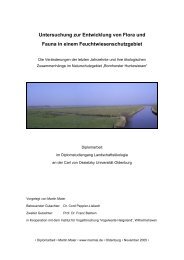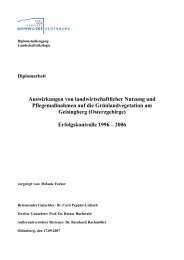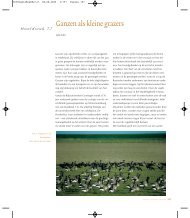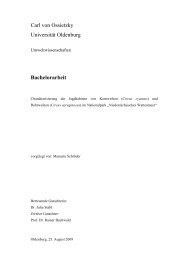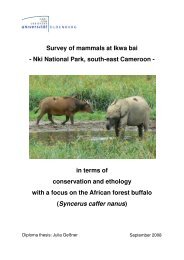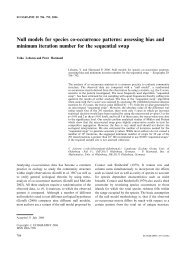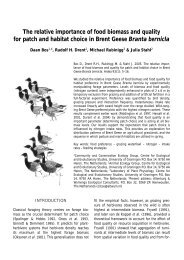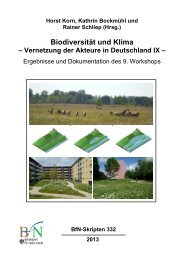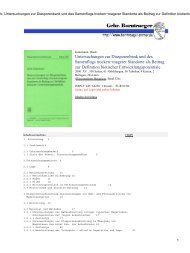Habitat use of barnacle geese at a subarctic salt marsh in the ...
Habitat use of barnacle geese at a subarctic salt marsh in the ...
Habitat use of barnacle geese at a subarctic salt marsh in the ...
Create successful ePaper yourself
Turn your PDF publications into a flip-book with our unique Google optimized e-Paper software.
652<br />
have to lay eggs, <strong>in</strong>cub<strong>at</strong>e and raise <strong>the</strong>ir young. It is<br />
extremely important for young birds to be able to<br />
forage on high-quality veget<strong>at</strong>ion <strong>in</strong> order to ga<strong>in</strong><br />
sufficient weight to undertake <strong>the</strong> southward migr<strong>at</strong>ion<br />
to <strong>the</strong> temper<strong>at</strong>e w<strong>in</strong>ter<strong>in</strong>g grounds (Gadallah and<br />
Jefferies 1995; Piedboeuf and Gauthier 1999; Person<br />
et al. 2003). Accord<strong>in</strong>g to <strong>the</strong> hypo<strong>the</strong>sis, <strong>the</strong> quality <strong>of</strong><br />
food on <strong>of</strong>fer from <strong>the</strong> peak stand<strong>in</strong>g crop <strong>in</strong> summer<br />
<strong>in</strong> more temper<strong>at</strong>e regions would be <strong>in</strong>sufficient to<br />
support <strong>the</strong> requirements <strong>of</strong> <strong>the</strong> birds and <strong>the</strong>ir young.<br />
However, <strong>the</strong> recent expansion <strong>of</strong> <strong>the</strong> breed<strong>in</strong>g range <strong>of</strong><br />
a variety <strong>of</strong> goose species seems to contradict this<br />
hypo<strong>the</strong>sis. A species th<strong>at</strong> recently expanded its<br />
breed<strong>in</strong>g range from <strong>the</strong> high Arctic to a wide range <strong>of</strong><br />
habit<strong>at</strong>s <strong>in</strong> sub-arctic and temper<strong>at</strong>e regions is <strong>the</strong><br />
<strong>barnacle</strong> goose (Van der Jeugd et al. 2003). In this<br />
study, we <strong>use</strong> <strong>the</strong> <strong>barnacle</strong> goose as a model to<br />
understand <strong>the</strong> habit<strong>at</strong> <strong>use</strong> <strong>of</strong> herbivorous migr<strong>at</strong>ory<br />
birds <strong>at</strong> a <strong>subarctic</strong> stag<strong>in</strong>g and breed<strong>in</strong>g site.<br />
Although <strong>salt</strong> <strong>marsh</strong>es are key habit<strong>at</strong>s <strong>in</strong> <strong>the</strong> life<br />
cycle <strong>of</strong> small avian herbivores like <strong>geese</strong>, our knowledge<br />
<strong>of</strong> <strong>salt</strong> <strong>marsh</strong>es around <strong>the</strong> Arctic Circle <strong>of</strong> <strong>the</strong><br />
Old World rema<strong>in</strong>s fragmentary. While several <strong>salt</strong><br />
<strong>marsh</strong>es <strong>in</strong> <strong>the</strong> Canadian and North American Arctic<br />
are well described (Jefferies 1977; Jefferies et al. 1979;<br />
V<strong>in</strong>ce and Snow 1984; K<strong>in</strong>cheloe and Stehn 1991),<br />
descriptions <strong>of</strong> <strong>the</strong> <strong>salt</strong> <strong>marsh</strong>es along <strong>the</strong> Russian part<br />
<strong>of</strong> <strong>the</strong> east Atlantic flyway are ei<strong>the</strong>r lack<strong>in</strong>g, or not<br />
accessible <strong>in</strong> Western liter<strong>at</strong>ure. In this study, we <strong>at</strong>tempt<br />
to fill this gap by describ<strong>in</strong>g different plant<br />
communities and <strong>the</strong>ir characteristics and mapp<strong>in</strong>g <strong>the</strong><br />
zon<strong>at</strong>ion <strong>of</strong> a <strong>salt</strong> <strong>marsh</strong> <strong>at</strong> an important stopover and<br />
breed<strong>in</strong>g site for migr<strong>at</strong><strong>in</strong>g <strong>geese</strong> <strong>in</strong> <strong>the</strong> Pechora Delta<br />
<strong>in</strong> Arctic Russia. We give special <strong>at</strong>tention to habit<strong>at</strong><br />
<strong>use</strong> by <strong>barnacle</strong> <strong>geese</strong>, as <strong>the</strong> area forms one <strong>of</strong> <strong>the</strong><br />
westernmost breed<strong>in</strong>g sites for <strong>the</strong> Russian popul<strong>at</strong>ion<br />
<strong>of</strong> this species.<br />
M<strong>at</strong>erials and methods<br />
Study site<br />
Fieldwork was carried out near <strong>the</strong> village <strong>of</strong> Tobseda<br />
(68°35.296¢N, 52°18.183¢E), <strong>in</strong> Kolokolkova Bay on <strong>the</strong><br />
west coast <strong>of</strong> <strong>the</strong> Pechora Delta (Fig. 1). The pen<strong>in</strong>sula,<br />
where <strong>the</strong> village <strong>of</strong> Tobseda is situ<strong>at</strong>ed, borders <strong>the</strong><br />
Pomorsky Channel <strong>of</strong> <strong>the</strong> Barentz Sea to <strong>the</strong> north and<br />
<strong>the</strong> Kambalnichya Pakha Gulf <strong>of</strong> Kolokolkova Bay to<br />
<strong>the</strong> south (Fig. 1). It is a low coastal terrace, which is<br />
be<strong>in</strong>g formed <strong>in</strong> two parallel ways: first, from <strong>the</strong> sea<br />
side due to <strong>the</strong> accumul<strong>at</strong>ion <strong>of</strong> sand along <strong>the</strong> open<br />
coast as a result <strong>of</strong> abrasion <strong>of</strong> <strong>the</strong> shore and sea<br />
bottom and, second, from <strong>the</strong> Kolokolkova Bay as a<br />
result <strong>of</strong> <strong>the</strong> sediment<strong>at</strong>ion <strong>of</strong> clayey deposits transported<br />
<strong>in</strong>to <strong>the</strong> bay by <strong>the</strong> Neruta River. A dune system<br />
has developed along <strong>the</strong> maritime terrace and <strong>salt</strong><br />
<strong>marsh</strong>es have established along <strong>the</strong> shores <strong>of</strong><br />
Kolokolkova Bay.<br />
The groundw<strong>at</strong>er depth <strong>in</strong> <strong>the</strong>se <strong>marsh</strong>es is shallow<br />
and, <strong>the</strong>refore, <strong>the</strong> groundw<strong>at</strong>er sal<strong>in</strong>ity is <strong>of</strong>ten similar<br />
to th<strong>at</strong> <strong>of</strong> seaw<strong>at</strong>er. Mov<strong>in</strong>g from <strong>the</strong> Kolokolkova Bay<br />
<strong>in</strong> <strong>the</strong> direction <strong>of</strong> <strong>the</strong> dunes, <strong>the</strong> <strong>marsh</strong>es become less<br />
sal<strong>in</strong>e and gradually turn <strong>in</strong>to sedge-moss bogs where<br />
freshw<strong>at</strong>er conditions prevail. With<strong>in</strong> <strong>the</strong> <strong>marsh</strong>es, <strong>the</strong>re<br />
are a number <strong>of</strong> small w<strong>at</strong>er bodies differ<strong>in</strong>g <strong>in</strong> sal<strong>in</strong>ity.<br />
The <strong>salt</strong> <strong>marsh</strong>es are potentially <strong>of</strong> gre<strong>at</strong> importance<br />
for migr<strong>at</strong><strong>in</strong>g <strong>geese</strong> and swans. S<strong>at</strong>ellite telemetry shows<br />
th<strong>at</strong> dark-bellied brent <strong>geese</strong> <strong>use</strong> <strong>the</strong> area as a stopover<br />
site dur<strong>in</strong>g spr<strong>in</strong>g migr<strong>at</strong>ion (Syroechkovsky and Litv<strong>in</strong><br />
1998; Green et al. 2002). On <strong>the</strong> return migr<strong>at</strong>ion <strong>in</strong><br />
autumn, <strong>the</strong> area aga<strong>in</strong> serves as an important stag<strong>in</strong>g<br />
post (Van Eerden 2000). On earlier expeditions (1996,<br />
1997), large numbers <strong>of</strong> <strong>barnacle</strong> <strong>geese</strong>, tundra bean<br />
<strong>geese</strong>, white-fronted <strong>geese</strong> and Bewick swans were observed<br />
<strong>in</strong> <strong>the</strong>se <strong>marsh</strong>es (Van Eerden 2000). In <strong>the</strong> past<br />
decade, <strong>the</strong> area has developed as a breed<strong>in</strong>g area for<br />
<strong>barnacle</strong> <strong>geese</strong> (Syroechkovsky 1995; Van der Jeugd<br />
et al. 2003), probably as an outcome <strong>of</strong> a reduction <strong>in</strong><br />
human disturbance, s<strong>in</strong>ce <strong>the</strong> nearby village was abandoned.<br />
Veget<strong>at</strong>ion classific<strong>at</strong>ion and mapp<strong>in</strong>g<br />
Veget<strong>at</strong>ion descriptions were made <strong>in</strong> 48 plots <strong>of</strong> 4·4 m.<br />
All species <strong>of</strong> vascular plants, mosses and lichens were<br />
recorded, follow<strong>in</strong>g <strong>the</strong> plant nomencl<strong>at</strong>ure <strong>of</strong> Czerepanov<br />
(1995). The abundance <strong>of</strong> all species was recorded<br />
by estim<strong>at</strong><strong>in</strong>g <strong>the</strong>ir percentage cover. The veget<strong>at</strong>ion<br />
descriptions were arranged <strong>in</strong> groups <strong>of</strong> plots with differ<strong>in</strong>g<br />
species and/or comb<strong>in</strong><strong>at</strong>ions <strong>of</strong> species with a high<br />
percentage cover. The result<strong>in</strong>g classific<strong>at</strong>ion m<strong>at</strong>ched<br />
th<strong>at</strong> <strong>of</strong> Leskov (1936), describ<strong>in</strong>g coastal <strong>salt</strong>-<strong>marsh</strong><br />
communities <strong>of</strong> <strong>the</strong> Barentz sea.<br />
Us<strong>in</strong>g this classific<strong>at</strong>ion (Table 1), we determ<strong>in</strong>ed<br />
<strong>salt</strong>-<strong>marsh</strong> veget<strong>at</strong>ion zon<strong>at</strong>ion along four transects,<br />
which were established on different parts <strong>of</strong> <strong>the</strong> <strong>salt</strong><br />
<strong>marsh</strong> <strong>in</strong> <strong>the</strong> summer <strong>of</strong> 2002 and were considered as<br />
four <strong>in</strong>dependent replic<strong>at</strong>es (Fig. 1). Transects ran perpendicular<br />
to <strong>the</strong> coastl<strong>in</strong>e <strong>in</strong> order to map zon<strong>at</strong>ion<br />
from <strong>the</strong> low <strong>salt</strong>-dom<strong>in</strong><strong>at</strong>ed <strong>marsh</strong>es to <strong>the</strong> dunes.<br />
Transects were 50 m wide and transects 1–4 were<br />
respectively 890, 1130, 1280 and 770 m <strong>in</strong> length.<br />
Transects were situ<strong>at</strong>ed <strong>at</strong> least 500 m apart from each<br />
o<strong>the</strong>r and were numbered from northwest to sou<strong>the</strong>ast.<br />
Transect 1 was close to <strong>the</strong> (abandoned) village, transect<br />
2 was loc<strong>at</strong>ed <strong>in</strong> <strong>the</strong> goose breed<strong>in</strong>g area and transects<br />
3 and 4 were placed towards <strong>the</strong> east. Transect 4<br />
was higher <strong>in</strong> elev<strong>at</strong>ion than transect 3 and also traversed<br />
ano<strong>the</strong>r small breed<strong>in</strong>g colony.<br />
In order to determ<strong>in</strong>e <strong>the</strong> veget<strong>at</strong>ion zon<strong>at</strong>ion with<strong>in</strong><br />
each transect, we walked a l<strong>in</strong>e-transect <strong>of</strong> 50 m width,<br />
with five people evenly spaced over <strong>the</strong> entire width <strong>of</strong><br />
<strong>the</strong> transect. The transect led from <strong>the</strong> <strong>in</strong>tertidal fl<strong>at</strong> to<br />
<strong>the</strong> dunes; and <strong>the</strong> plant community was recorded by<br />
every person every 10 m, us<strong>in</strong>g <strong>the</strong> classific<strong>at</strong>ion <strong>in</strong><br />
Table 1.




